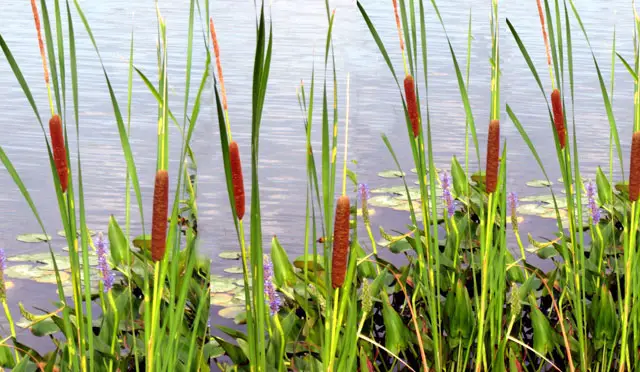Contributing Writer for Wake Up World
One of the most common wild plants found throughout the world, cattail, is astoundingly versatile. So much so that it can make the difference between life and death if one is lost in the wilderness or when food is in short supply. But this humble plant is also extremely handy in ordinary, day-to-day situations too. If you have access to an area with cattail, an exceptional survival resource is right at your fingertips.
Year-round usefulness
Most of us have come across cattail at one time or another. Distinguished by a brown cigar-shaped head on a hearty stalk, cattail grows in wet areas often close to streams, ponds and lakes. As one of the most functional wild plants, cattail offers different uses during each season.
Early spring
Fresh shoots begin to sprout and can be dug up and (once peeled) eaten raw or sauteed. Additionally, the lower part of the leaves can be added to salads.
Summer
This is the season when the uses for cattail are most abundant. Once a stem is pulled from the ground, you will notice the lower part is white. When eaten raw, it tastes similar to cucumber. Cooked, it tastes like corn. Lower cattail stalks are a good source of vitamins A, B and C along with potassium and phosphorus. During midsummer, a yellow pollen appears that can be used as flour or thickener for soups and stews. To harvest the pollen, bend the cattail head into a paper bag and shake. In late summer, green flower spikes appear and can be eaten like corn on the cob.
Autumn
The root of cattail can now be harvested. Wash thoroughly and submerge in water – let sit until a gel forms. Drain the gel and use for bread making and soups. For a protein-rich flour, dry the roots and grind. It can also be roasted and ground for a healthy coffee substitute.
Winter
In northern climates, cattail root is difficult to collect, but not impossible if you can break through frozen ground and ice. In late winter, new shoots begin to emerge, once again providing a food source.
Cattail also has many other uses. The brown, tight heads are often dry at the core (even after heavy rain) and can be used as survival tinder. Likewise, dipping the head in oil or fat will create a useable torch. Similar to down, the head yields a fluffy wool when broken apart and serves as excellent insulation for pillows, mattresses and clothing. If lost in the wilderness, a makeshift bed made with cattail down will help protect against heat loss, while the long leaves of the plant can be woven into mats and shelters. Medicinally, the gel found within the leaves act as a topical anesthetic. And a poultice made from the roots will soothe stings, burns and cuts.
Before trotting off to reap the benefits of cattail, a word of warning from Kat Morgenstern of Sacred Earth:
“Personally I do not harvest any roots or shoots in order to avoid negatively impacting next year’s growth. The pollen and the cobs are by far the safest and easiest parts to collect. Furthermore, it requires some skill to distinguish young cattails from young Yellow Irises – which are poisonous, so unless you are an experienced forager and know how to distinguish these plants before their flowering parts appear, it may be better to leave those young plants alone.
“Last, but not least, cattail is said to have a certain emmenagogue action and should therefore be avoided during pregnancy.”
Updated October 2014
Sources:
http://food-nutrition.knoji.com
Previous articles by Carolanne:
- Common Toxin in Your Pantry Causes Obesity, Diabetes, Infertility… and Much More
- Is Mold Making You Sick?
- Hemp – The Ultimate Cash Crop, Health Food and Environmental Savior Rolled Into One
- Slash your Organic Food Bill by Almost 90 Percent with This One Simple Method
- Confirmed by Science: You Really Can Change Your DNA – Here’s How
- Chemtrails: Learn How to Protect Yourself From These Treacherous Poisons
- Top 10 Food Frauds: Formaldehyde, Plastic, Melamine & Caustic Soda Found in Common Foods
- Autistic Boy With Higher IQ Than Einstein Discovers Gift After Removal From State-Run Therapy
- Enhance Spiritual, Mental and Physical Well-being with a Pineal Gland Detox
- Enterprising Community Aims for Total Food Self-Sufficiency with Free Edible Landscapes
- The Silent Toxin in Food that Provokes Cancer, Diabetes, Multiple Sclerosis and More
- DIY $2 Self-Watering Garden Bed – Grow Produce Easily, Even in the Toughest Drought Conditions
About the author:
I’m Carolanne — a writer, chef, traveler and enthusiastic advocate for sustainability, organics and joyful living. It’s good to have you here. If you would like to learn more, connect with me at Thrive-Living.net or visit Twitter.com/Thrive_Living.
If you've ever found value in our articles, we'd greatly appreciate your support by purchasing Mindful Meditation Techniques for Kids - A Practical Guide for Adults to Empower Kids with the Gift of Inner Peace and Resilience for Life.
In the spirit of mindfulness, we encourage you to choose the paperback version. Delve into its pages away from screen glare and notifications, allowing yourself to fully immerse in the transformative practices within. The physical book enriches the learning process and serves as a tangible commitment to mindfulness, easily shared among family and friends.
Over the past few years, Wake Up World has faced significant online censorship, impacting our financial ability to stay online. Instead of soliciting donations, we're exploring win-win solutions with our readers to remain financially viable. Moving into book publishing, we hope to secure ongoing funds to continue our mission. With over 8,500 articles published in the past 13 years, we are committed to keeping our content free and accessible to everyone, without resorting to a paywall.
Please note: this article was first published on Natural News.








